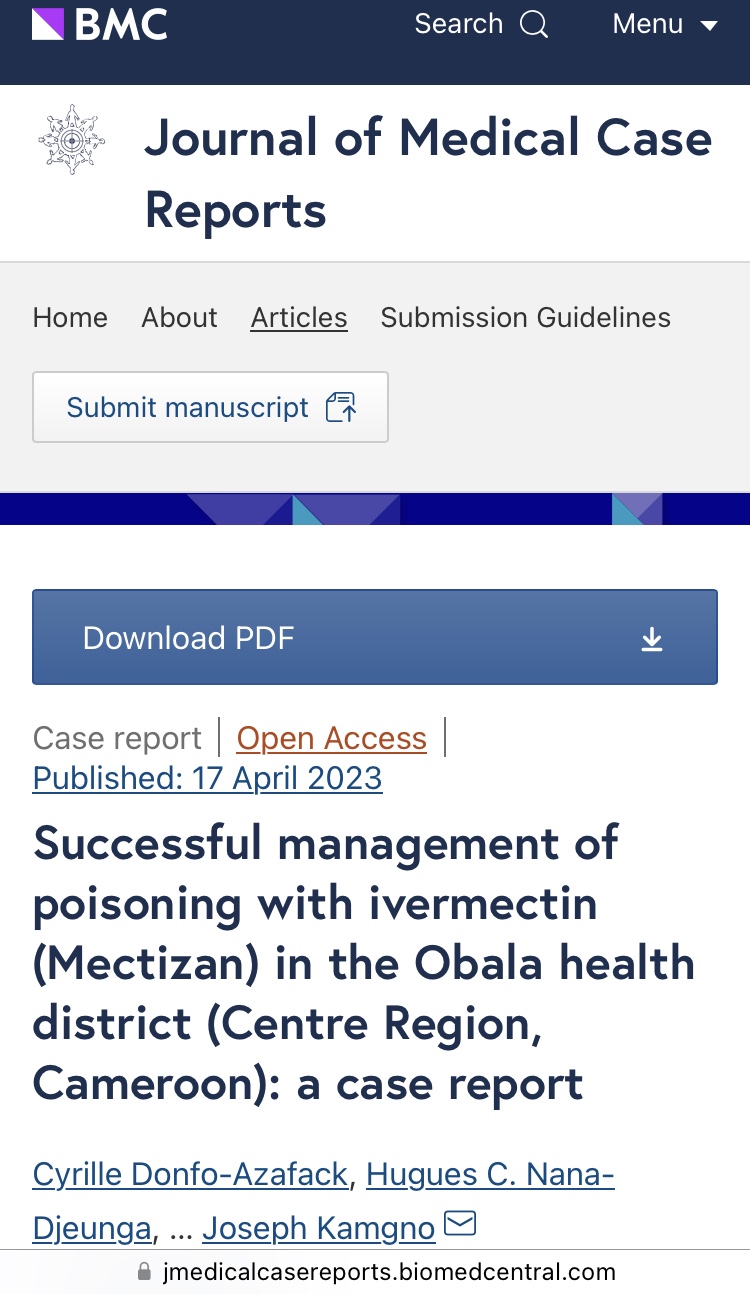Talk about a cry for help by a young girl. People have access to large quantities of Ivermectin pills in Africa because it is such an essential, cheap and ubiquitous drug (remember, Ivermectin was called one of the three most important human drugs in history along with penicillin and aspirin – the P.I.A. Triumvirate – up until… Q1 of ARSH 2020), which is how she was able to take so much at once. She took 400 3mg pills. The standard antiparasitic dose for an average adult is roughly is 12mg, so she took a X100 dose.
She got punchy, barfy, sleepy and had wonky vision. She was released from the hospital on day four, and started university several months later.
I’m sorry this girl had a fight with her father and did this, BUT now we have a recorded incidence of Ivermectin “poisoning” PUBLISHED IN THE SCIENTIFIC LITERATURE which sounds to me to be milder than three rounds of French 75s made with Gordon’s Gin (that stuff is legit poison – never drink any gin that is sold at the supermarket, but especially Gordon’s 🤮.)
Ivermectin: The Safest Drug In The World
Tell a friend.
I hope this helps.
https://jmedicalcasereports.biomedcentral.com/articles/10.1186/s13256-023-03891-4

Case presentation
A 19-year-old Black female student residing in Obala (Centre Region, Cameroon) in Central Africa, was admitted in the Obala District Hospital on December 12, 2018 with a mildly altered state of consciousness [Glasgow Coma Score (GCS) of 13/15], after consuming a large quantity of ivermectin 3 mg tablets. Indeed, after an argument with her father when returning from school 1 day before admission to the hospital, the patient voluntarily swallowed about 400 ivermectin 3 mg tablets with suicidal intention. She opened a sealed box of 500 tablets of ivermectin 3 mg and when she was found in an altered state of consciousness (GCS 13/15), less than 100 tablets were remaining. About 1–2 hours after ivermectin intake, the patient experienced several episodes of vomiting containing some tablets, asthenia, and a mild altered state of consciousness. The persistence of the symptoms prompted her family to take her to the hospital. On admission, the patient was conscious but presented with an altered general state (asthenia and anorexia), nausea, rotatory vertigo, headache, and visual problems. All her vital signs were normal, but her Glasgow Coma Score was 13/15. Physical examination revealed bilateral mydriasis and reactive pupils, regular heartbeat with a 2/10 functional murmur at the mitral focus, and marked abdominal tenderness at the right iliac fossa. Neurological examination showed a kinetic ataxia with a small increase of tendon reflex. Uncorrected visual acuity was 1/10 for both eyes. Paraclinical examinations consisted of an abdominopelvic ultrasound showing a dilatation of the digestive loops with hyperperistalsis in favor of a spasmodic disorder and epigastric sensitivity at the passage of the probe. An electrocardiogram and electroencephalogram were normal. As for biological assessment, her blood count was normal, uremia and creatinemia were normal, while serum electrolyte test revealed a decrease in potassium concentration at 3.37 Meq/L (3.5–5.4 Meq/L), likely associated with vomiting. The assessment of liver function [transaminase, bilirubin, and gamma-glutamyl transferase (GGT)], the fundus, and the eye scanner were normal. The post-ivermectin Loa loa microfilarial density, following a calibrated thick blood smear, was negative.
Of note, a notion of visual pathology was reported in her family, and she reported a visual disturbance prior to the intoxication that never required consultation. The patient also had a past medical history of unconfirmed asthma. She is the third of five siblings with two half-sisters, living with her father and mother-in-law, and had no known psychiatric pathology. She had no known allergy to any drug and had never swallowed ivermectin before this unfortunate event.
Management consisted of saline-based hyper-hydration, antiulcer (omeprazole 40 mg daily) for gastritis, paracetamol 1 g in case of headache, and monitoring of hemodynamic parameters. The evolution was satisfactory from day 2 to day 4 with a decrease of vertigo, asthenia, and ataxia, but a persistent decrease in visual acuity. She was discharged on day 4 despite slight asthenia and visual impairment. One month later, she was psychiatrically stable but presented with persistent visual disturbance. Six months after discharge, she passed the baccalaureate examination and was admitted at the university. She has been diagnosed with, and is currently treated for, myopia and hyperopia, likely present a while before the intoxication event.
